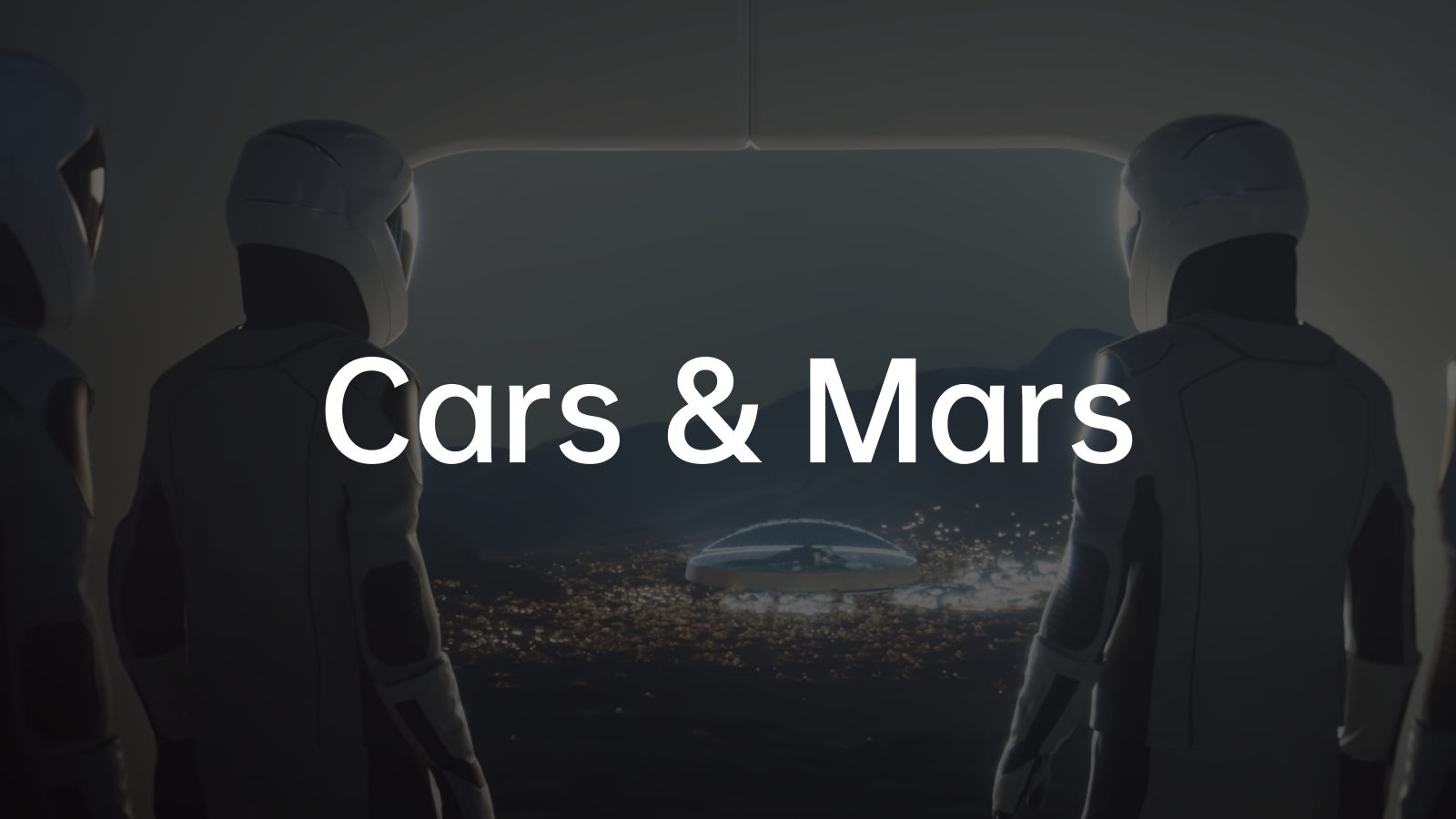On March 17 of this year, Musk tweeted that he is developing “The Master Plan, Part III”. Based on the fact that the second part only took 11 days to complete, it might be possible that the recent Twitter acquisition event slowed down Musk’s progress in developing the third part of the master plan.
Fortunately, Musk teased some details about “The Master Plan, Part III” on March 21, which I’m sure those who follow Tesla, like myself, are eagerly waiting for more information on.
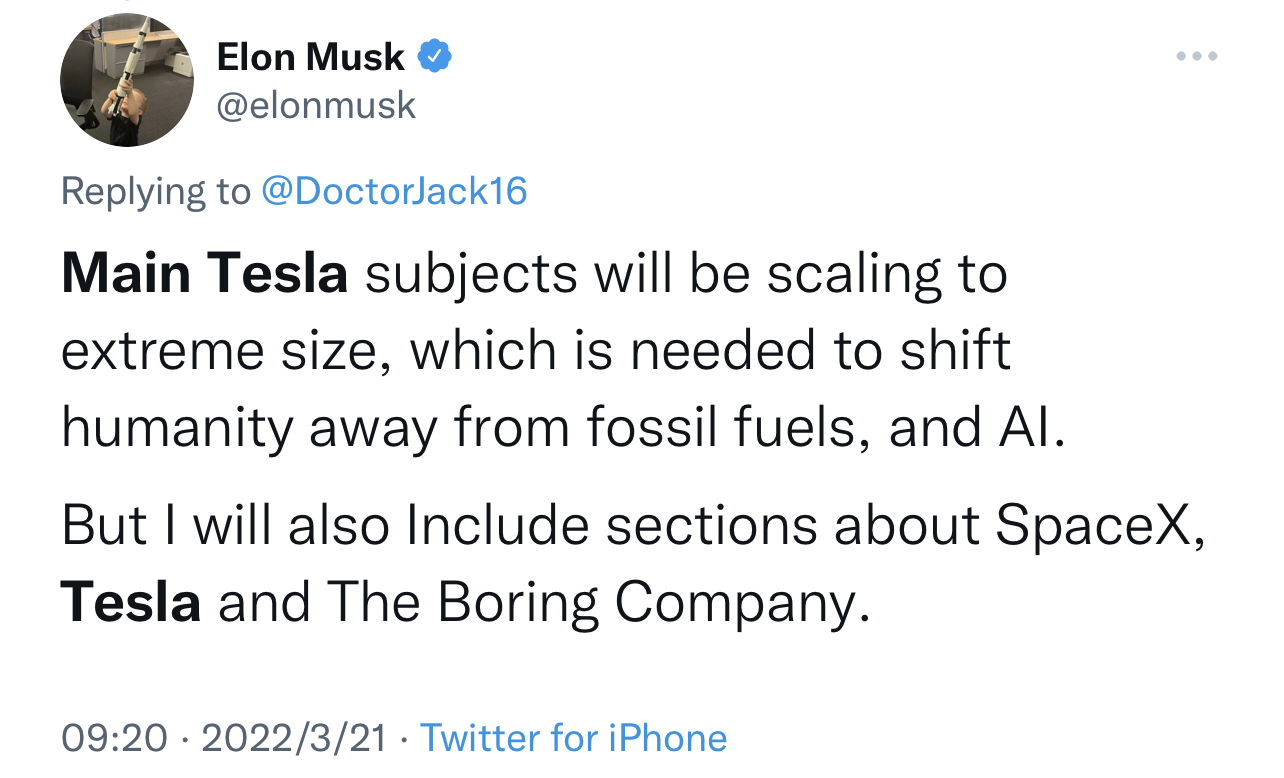
So, let’s take a look at some of the leaked information from Musk’s tweet, as well as numerous interviews Musk has given in recent years and some of his companies’ business trends, to speculate on what “The Master Plan, Part III” involving SpaceX, Tesla, and The Boring Company might entail.
Review of Master Plan Parts I & II
In August 2006, Musk published Tesla’s first master plan on the official Tesla blog. He wanted to gradually introduce more affordable electric car models after the Roadster. Over the next 10 years, Tesla released the Model S and Model X, which were similarly priced but more practical than the Roadster, and finally changed its fate with the release of the Model 3 in March 2016. Thus, the first Master Plan could be considered successful.
In July 2016, Musk released Tesla’s second master plan which aimed to seamlessly integrate solar power generation with static storage, launch its electric vehicles in various market segments, make vehicle autonomous driving 10 times safer than human driving through data learning from vehicle fleets, and launch the Robotaxi autonomous driving rental business. As of 2022, it seems that all of the plan’s goals, except for the Robotaxi business, have either been completed or are nearing completion.
The First Half of Master Plan 3: Achieving Sustainable Energy Transition on Earth
In his teaser tweet, Musk indicated that the focus of the Master Plan 3 for Tesla will be scaling, to the point where humanity can break free from its dependence on fossil fuels. This has been Tesla’s mission since its inception, and as Musk emphasized at the opening ceremony of the Texas factory, to achieve true sustainability, Tesla must produce a large number of cars and stationary energy storage devices. In addition, the appearance of keywords such as AI and The Boring Company hints at Tesla’s efforts to further strengthen the sustainable energy development of the transportation sector.
GigafactoriesIn the Tesla shareholder meeting in October 2021, Musk stated that he hoped Tesla could achieve an annual sales target of 20 million vehicles by 2030.
In March 2022, at the opening ceremony of the Berlin Super Factory in Germany, Musk again mentioned that he hoped Tesla can achieve an annual production capacity of 20 million vehicles within a decade, as there are 2 billion cars and trucks globally that can be used normally. This means that Tesla will occupy 1% of the global market share annually.
When asked how many super factories Tesla will have in 10 years, Musk hesitated and said: “There will probably be ten super factories.”
In fact, this is necessary for Tesla because it currently only has four super factories that produce cars in Fremont, Shanghai, Berlin, and Texas, one factory in Nevada that produces battery and energy storage products, and one in Buffalo, New York that produces solar energy products. Based on information revealed during Tesla’s 2021 full-year financial report conference, the location of the next super factory will be announced by the end of 2022.
Even if the Berlin and Texas super factories climb smoothly, and the second phase of the Shanghai factory is completed successfully, it is obvious that Tesla’s global accumulated annual production capacity is only about 4 million vehicles, so Tesla must quickly build more super factories in the next few years to meet its ambitious goal of selling 20 million vehicles annually by 2030.
Production Efficiency
If the number of factories is not enough, make up for it with production efficiency.
Musk once said that he hoped Tesla’s super factories could have raw materials on one side and assembled cars on the other. If reality permits, Musk would probably want the factory to be built directly next to the raw material mines to reduce transportation costs to some extent.
In reality, Tesla has indeed realized this vision in the Texas Super Factory. Musk said at the opening of the Texas Super Factory that raw materials can enter one end of the factory and the complete vehicle can emerge from the other end after a series of processing. To minimize the transportation costs between materials, and make efficient use of every cubic meter of space, the Texas Super Factory has placed battery manufacturing, electric drive manufacturing, stamping, die casting, welding, painting, and assembly and all other processes under one roof, which has also made it the largest single factory in North America.And with the already highly praised one-piece casting process, as well as the structural battery based on 4680 cells, Tesla is far ahead of other car companies in terms of production efficiency. Volkswagen CEO Diess gave very high praise to Tesla’s super factory in Berlin in his internal speech in 2021. He believes that Tesla’s long-standing production quality problems are being solved, combined with its advantages in software, battery life, and performance, Tesla will become even stronger. Especially in the manufacturing field, he estimates that Tesla will only use 7,000 manpower to achieve an annual production of 500,000 vehicles at the Berlin super factory, which is twice as efficient as Volkswagen’s Zwickau factory in Germany.
Battery
The importance of batteries to electric vehicles may be fully reflected this year. Musk once tweeted that battery production capacity is the basic factor limiting the world’s transition to sustainable energy. This can be seen not only from Tesla’s joint venture with Panasonic to manufacture batteries, but also from its deep cooperation with battery giants such as LG Chemicals and CATL.
At the opening ceremony of the Texas super factory, Musk said that over time, the Texas super factory will become the largest battery production plant in the world. According to data released by Tesla at the 2020 Battery Day event, it plans to produce 100 GWh in 2022 and more than 3 TWh of batteries by 2030.
To this end, Tesla will also enter the mining of raw materials. Although Tesla has not taken direct action in this regard, it has been collaborating with battery raw material mines.
Last weekend, Indonesian media reported that, according to the contents of the recent meeting between the Indonesian president and Musk, the Minister of Investment Affairs of the government stated that Tesla had reached an agreement with the Indonesian government to build a factory for producing electric vehicles and batteries in Java, Indonesia. The minister told the media: “According to current plans, Tesla will enter Indonesia this year. But I cannot announce which month specifically, let’s wait a little longer, because we have not yet signed a specific agreement. The amount of investment is currently confidential, so let’s wait a little longer. This is a big deal, a good thing.”
It is reported that the Indonesian government has tried to introduce Tesla many years ago, but the recent public report in early this month has further increased the possibility of cooperation between the two sides. Indonesia is an indispensable element in the ternary lithium-ion battery because of its rich nickel mine resources; If this report is true, it will undoubtedly be an important milestone for Tesla to accelerate large-scale battery production.
The Boring Company
In early March of this year, Musk tweeted: “Conquering traffic congestion is the ultimate battle, because even the most powerful people in the world cannot avoid traffic congestion. After the appearance of autonomous driving cars, people will no longer feel the pain of driving, so the increase in vehicle utilization rate will exacerbate traffic congestion.”Elon Musk’s concern is not without reason. The emergence of autonomous driving will inevitably lead to more cars appearing on the roads with higher frequency. Autonomous driving models that could have improved energy efficiency may waste more energy in endless traffic jams, thereby weakening the effect of improving energy efficiency. Musk’s solution to urban congestion is to use a 2D road traffic system to solve problems caused by people living in a 3D space. This is clearly stated on Boring Company’s official website.
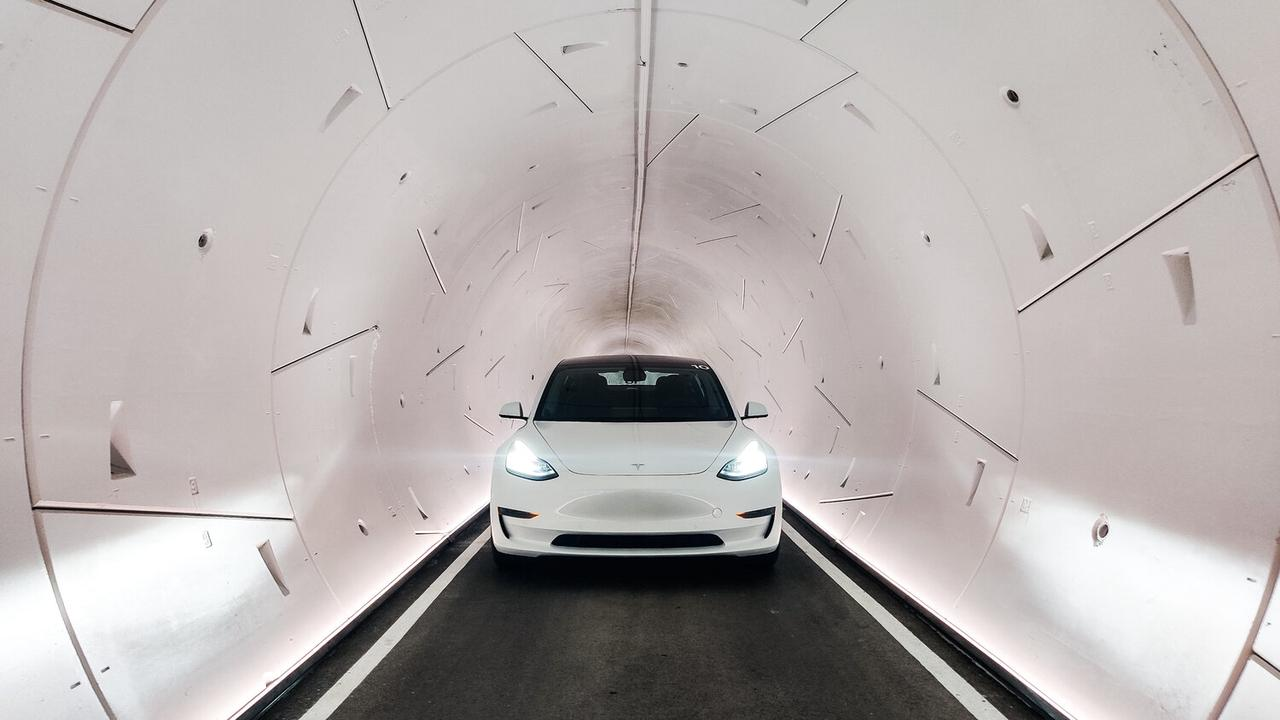
In a recent interview with the Financial Times, Musk reiterated this point and pointed out that more vertical tunnels should be built to solve this problem. The construction of tunnels is not affected by the vertical direction, similar to high-rise buildings on the ground.
Boring Company has already opened a section of underground tunnels in Las Vegas with three stations and a transport capacity of 4,400 passengers per hour. The planned Las Vegas line will have 51 stations and a transport capacity of more than 57,000 passengers per hour. This transport capacity can greatly alleviate congestion in the city center and improve the energy efficiency of vehicles.
AI
AI, artificial intelligence, is a point that Tesla has often mentioned in the past two years. Musk also specifically mentioned AI in this grand plan. Based on Tesla’s current public information, products directly related to AI include autonomous driving and Tesla Bot, which includes the models that are already in production with FSD capabilities and Robotaxi models, which will debut in 2024.
Perhaps some people may wonder what the connection between AI and accelerating the world’s shift to sustainable energy is? For example, Google Maps launched a project called “Green Route” last year. Based on its AI and big data algorithm, it can recommend the fastest route to drivers while also recommending more economical “green routes” because this can reduce fuel consumption to a certain extent. The same principle also applies to AI-driven Tesla Robotaxi.
Musk has stated that he hopes the energy consumption of Robotaxi can reach 5 miles/kWh according to EPA standards, which is 10% higher in efficiency than Model 3. Referring to the carbon emissions reduced by Tesla’s global fleet in 2021, if the vehicles in these fleets have energy consumption levels similar to Robotaxi, the carbon emissions reduced for the whole year of 2021 can increase from the original 6.8 million tons to 7.6 million tons.## The Grand Plan 3 Second Half: Making Humanity a Multi-planetary Species
“In my opinion, it is crucial for humanity to become a multi-planetary species because the sun will eventually expand and destroy the Earth. If people truly care about the future of humanity, they should make us a multi-planetary species.” Elon Musk said in a recent media interview. Perhaps the turbulent international situation in the past two years has made Musk more convinced of the necessity of making humanity a multi-planetary species, so SpaceX appears in this grand plan.
SpaceX
If The Boring Company’s appearance in this grand plan spoiler was somewhat unexpected, then SpaceX’s appearance makes this grand plan full of imagination.
Just earlier this month, Gwynne Shotwell, COO of SpaceX, said in an interview with American CNBC TV that they plan to transport humans to Mars by 2030. With a large amount of cargo transported to Mars, people will consider Mars as a place where humans can go in five to six years.
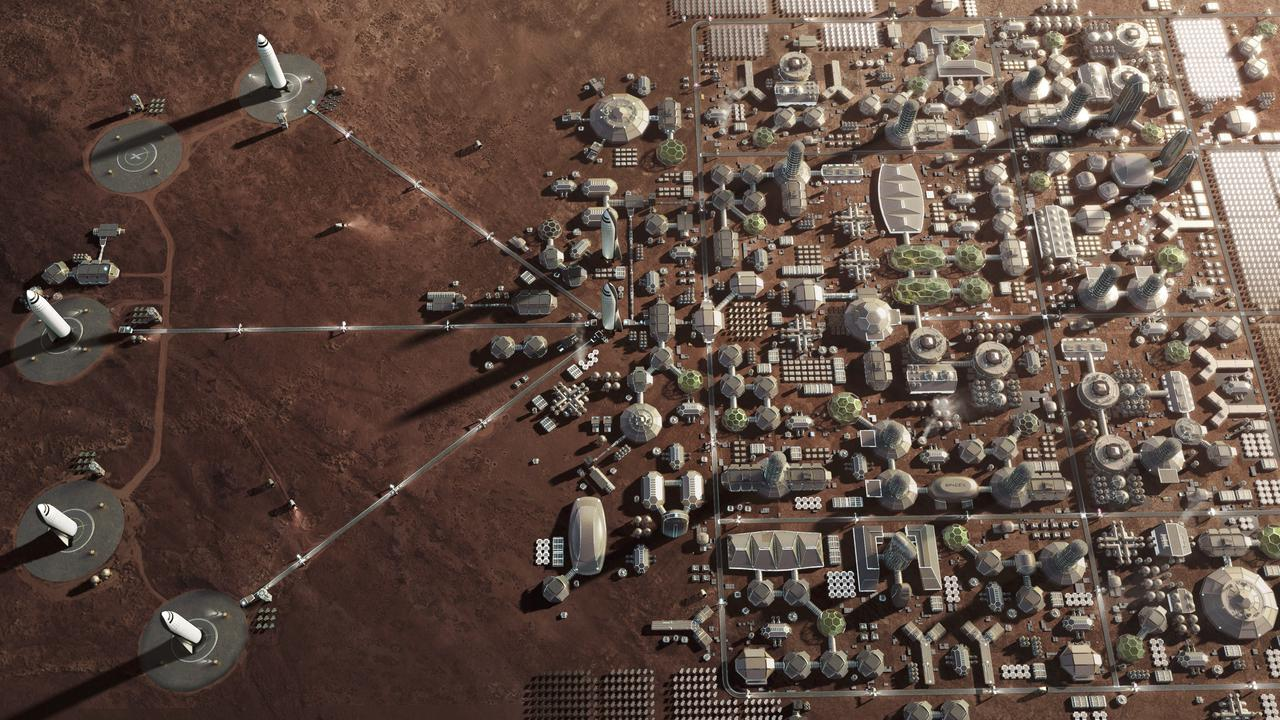
Coincidentally, Musk also confirmed in a recent interview that he plans to fly the Starship spacecraft without crew within three to five years. If the test is successful, humans will be transported to Mars for the first time before 2030.
The transportation tool to Mars, the Starship spacecraft, is ready to go and can transport over 100 tons of cargo each time. Now, let’s imagine. If you were Musk, what would you transport in the 100 tons of cargo?
Imagine that, according to SpaceX’s plan, when we need to transport humans to Mars and make Mars a place where humans feel they can go, a large amount of infrastructure construction is naturally needed. The question is, who will participate in these construction workers? Perhaps you already guessed it: Tesla Bot.
Tesla Bot
When Musk announced the Tesla Bot at the AI Day last year, he stated that its main purpose is for tasks that humans find boring, dangerous or repetitive. In the 2021 full-year earnings call not long after, Musk made it clear that Tesla Bot’s primary functionality will be within Tesla factories, mainly used for carrying some components and related tasks.
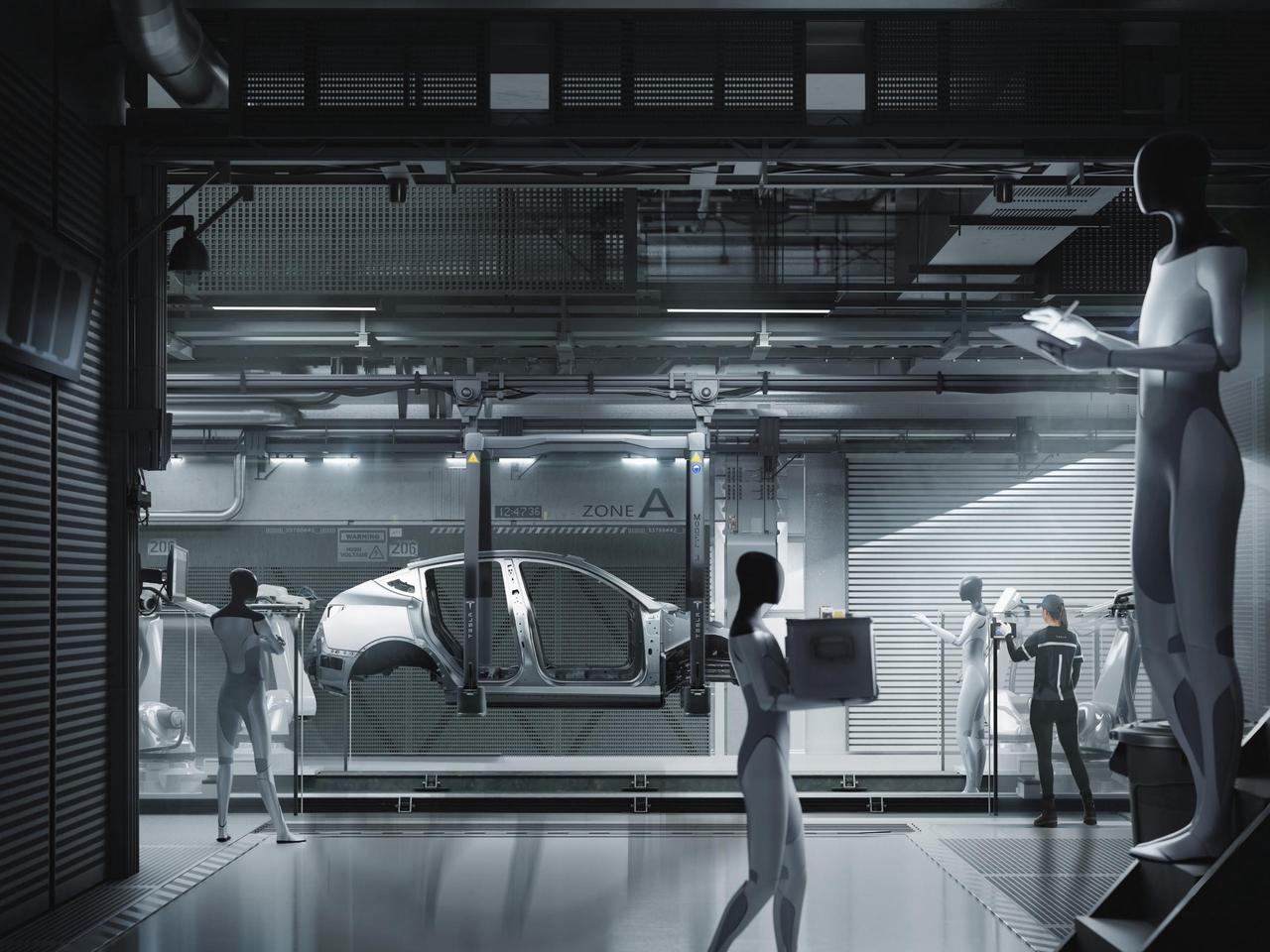 The birth of non-automotive products such as Tesla Bot, as well as Tesla’s high attention to this product in the past two years, to some extent, reflect that Tesla is no longer satisfied with the data generated in a limited environment of vehicles and provides it with help in artificial intelligence. Because if we want to solve real-world artificial intelligence, the data generated in road environments is only a small part of the world. As a humanoid robot, Tesal Bot will have a significantly larger range of operation than cars; in addition, it also uses the same visual perception system and computing platform as FSD, so the data from FSD can support the pre-research and development of Tesal Bot; similarly, the data generated after Tesal Bot is put into use can also support FSD. This forms a perfect closed-loop of data application.
The birth of non-automotive products such as Tesla Bot, as well as Tesla’s high attention to this product in the past two years, to some extent, reflect that Tesla is no longer satisfied with the data generated in a limited environment of vehicles and provides it with help in artificial intelligence. Because if we want to solve real-world artificial intelligence, the data generated in road environments is only a small part of the world. As a humanoid robot, Tesal Bot will have a significantly larger range of operation than cars; in addition, it also uses the same visual perception system and computing platform as FSD, so the data from FSD can support the pre-research and development of Tesal Bot; similarly, the data generated after Tesal Bot is put into use can also support FSD. This forms a perfect closed-loop of data application.
With Tesla’s continuous exploration of real-world artificial intelligence, the Tesla Bot trained in Tesla factories will have preliminary functions of handling and assembling. This can undoubtedly play a crucial role in the process of building Mars. After all, we cannot rely on a limited number of humans transported to Mars to do those boring, dangerous, and repetitive work.
In fact, this view is not impossible to find traces of. Shortly after last year’s AI Day, some netizens on Twitter speculated whether Tesla would mass-produce Tesla Bots and transport them to Mars for terraforming and other work. Musk’s reply was meaningful, “Hopefully”.
Tesla Energy
In 2016, Tesla acquired “SolarCity,” founded by Musk and his cousin, which is now Tesla’s energy department. Currently, in addition to photovoltaic products such as Solar roof and Solar panel, Tesla also has static energy storage products such as Powerwall, Powerpack, and Megapack. Such energy products, combined with Tesla’s own batteries, cars, and software services, constitute Tesla’s entire ecosystem.
Musk has repeatedly emphasized that with a large enough area of solar panels and corresponding static energy storage devices, it is possible to produce and reserve the energy consumption of the entire earth. The same applies to Mars. Although scientific reports show that the solar power generation efficiency on Mars is far lower than that on Earth, compared with nuclear power and wind power generation, solar power generation is more suitable for the initial stage of Mars construction from both operational and demand levels. With a certain amount of static energy storage equipment, an energy system on Mars can be established.Apart from the projects that are highly likely to be used for Mars immigration, in the past two years, it has also been reported that Musk has been actively experimenting on the issue of human habitation on Mars. Musk himself tweeted that he lived in a $50,000 house in the southern part of Texas for the past two years. In addition, Musk’s brother’s company, BIG GREEN, is also believed by the public to be a company established for immigrating to Mars, as the company’s main business is to cultivate people from childhood on how to grow green and healthy vegetables. Of course, we cannot forget the Cybertruck, which is said to be the Mars pickup. It can be said that within the scope of information we can grasp, Musk has already begun to layout people’s food, shelter, and transportation on Mars.
In conclusion
Since its establishment in 2003, the name of Tesla has changed from “Tesla Motors” to “Tesla,” and its official domain from teslamotor.com to tesla.com. Tesla was once thought to be a car company that manufactures electric cars, but after its acquisition of SolarCity and starting its own battery production, we thought it was an energy company. After Tesla developed its own self-driving chip, gradually released FSD Beta, and released Tesla Bot, Tesla transformed into an AI company.
In the process of gradually implementing every grand plan, Tesla’s corporate attributes are constantly iteratively updated, from initially solving the energy problem of mankind, to the transportation problem, and now to the problem of human civilization. Until this third grand plan, Musk can no longer limit his planning to just within Tesla, because accelerating the Earth’s transition to sustainable energy or realizing human’s becoming a multi-planetary species is not just Tesla’s grand plan, but also Musk’s grand plan.
Just as Musk said in his tweet: “Working on Master Plan Part 3”, which is not prefixed with “Tesla Master Plan” like it was when releasing the second grand plan.
This article is a translation by ChatGPT of a Chinese report from 42HOW. If you have any questions about it, please email bd@42how.com.
